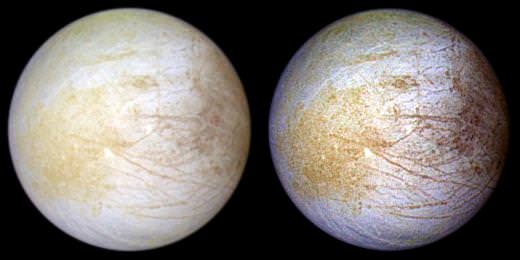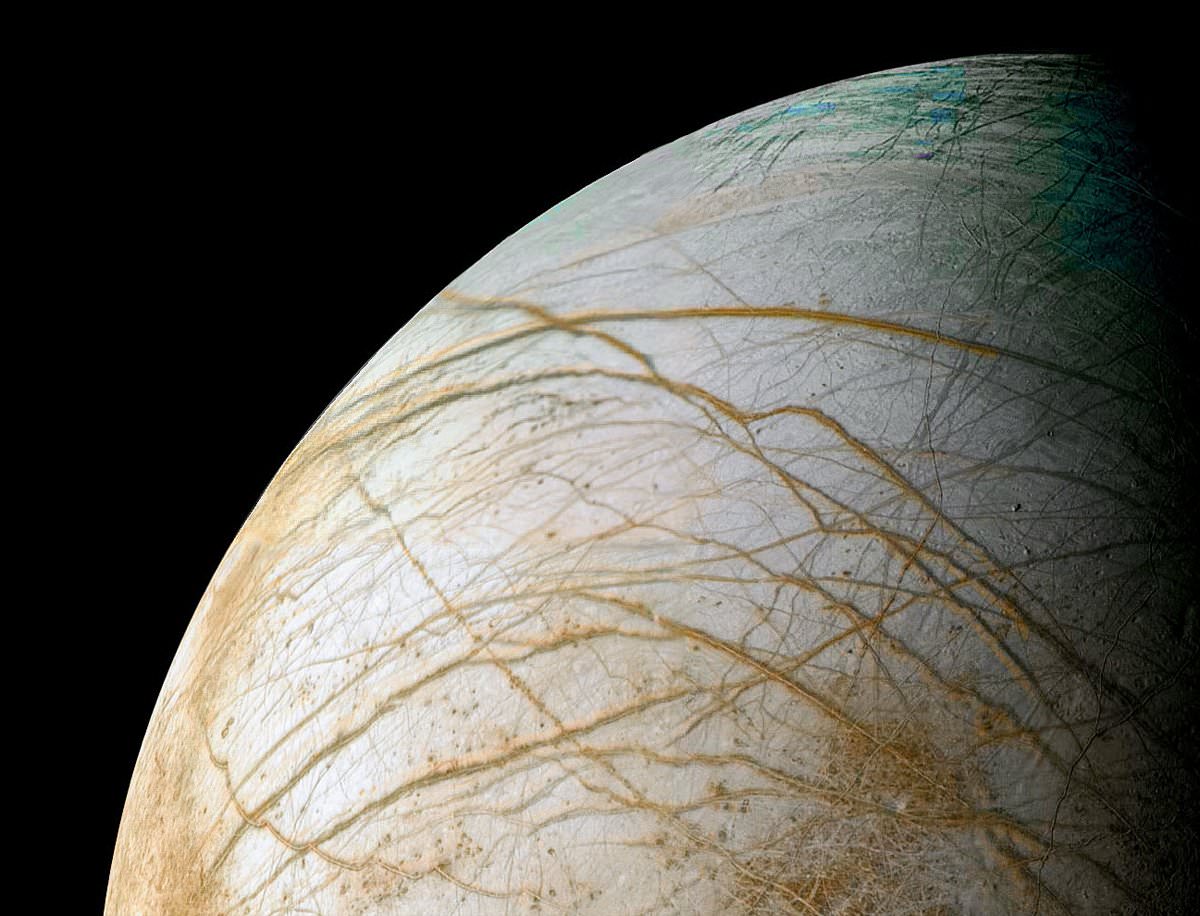According to research by NASA astronomers using the next-generation optics of the 10-meter Keck II telescope, Jupiter’s ice-encrusted moon Europa has hydrogen peroxide across much of the surface of its leading hemisphere, a compound that could potentially provide energy for life if it has found its way into the moon’s subsurface ocean.
“Europa has the liquid water and elements, and we think that compounds like peroxide might be an important part of the energy requirement,” said JPL scientist Kevin Hand, the paper’s lead author. “The availability of oxidants like peroxide on Earth was a critical part of the rise of complex, multicellular life.”
The paper, co-authored by Mike Brown of the California Institute of Technology in Pasadena, analyzed data in the near-infrared range of light from Europa using the Keck II Telescope on Mauna Kea, Hawaii, over four nights in September 2011. The highest concentration of peroxide found was on the side of Europa that always leads in its orbit around Jupiter, with a peroxide abundance of 0.12 percent relative to water. (For perspective, this is roughly 20 times more diluted than the hydrogen peroxide mixture available at drug stores.) The concentration of peroxide in Europa’s ice then drops off to nearly zero on the hemisphere of Europa that faces backward in its orbit.
Hydrogen peroxide was first detected on Europa by NASA’s Galileo mission, which explored the Jupiter system from 1995 to 2003, but Galileo observations were of a limited region. The new Keck data show that peroxide is widespread across much of the surface of Europa, and the highest concentrations are reached in regions where Europa’s ice is nearly pure water with very little sulfur contamination.

The peroxide is created by the intense radiation processing of Europa’s surface ice that comes from the moon’s location within Jupiter’s strong magnetic field.
“The Galileo measurements gave us tantalizing hints of what might be happening all over the surface of Europa, and we’ve now been able to quantify that with our Keck telescope observations,” Brown said. “What we still don’t know is how the surface and the ocean mix, which would provide a mechanism for any life to use the peroxide.”
Read more: Evidence for a Deep Ocean on Europa Might Be Found on its Surface
The scientists think hydrogen peroxide is an important factor for the habitability of the global liquid water ocean under Europa’s icy crust because hydrogen peroxide decays to oxygen when mixed into liquid water. “At Europa, abundant compounds like peroxide could help to satisfy the chemical energy requirement needed for life within the ocean, if the peroxide is mixed into the ocean,” said Hand.
(Source: NASA)
What’s notable to add, on March 26, 2013, the U.S. President signed a bill that would increase the budget for NASA’s planetary science program as well as provide $75 million for the exploration of Europa. Exactly how the funds will be used isn’t clear — perhaps for components on the proposed Europa Clipper mission? — but it’s a step in the right direction for learning more about this increasingly intriguing world. Read more on SETI’s Destination: Europa blog.


Io, Europa & others in our solar system have so much to offer as we learn about them. They look to be ‘snap-shots’ of certain areas of our planet earth growth. More R&D w/probes must be a priority to us all in space science. If we are to advance our knowledge in our first steps in this vast solar system. This will enhance our further steps into our galaxy.
To me dark matter & dark energy are controlling the “dimension(s)” with in the “FABRIC” of the universe. So I am a thinking-dreamer. Someone has to do it…lol. Think deep like Star-Trek & beyond like Buzz-Light Year :-)… . Take care all.
ALL THESE WORLDS
ARE YOURS EXCEPT
EUROPA
ATTEMPT NO
LANDING THERE
Don’t tell my kids. “NO PEROXIDE!!!!!”
This conjecture works if the hydrogen peroxide H_2O_2 is generated in the interior. What has to be ruled out is that it is generated by the activation or excitement of molecular levels in H_2O by some form of radiation incident on the surface.
LC
Wait… Didn’t the article explicitly say that the hydrogen peroxide is being generated at the surface by radiation from Jupiter’s magnetic field?
well the field would effect more than just the surface but H2O2 is only being seen on the leading side. i would suspect it’s being made from energetic particle wash. it still needs to be mixed into the subsurface water. a slow process i rekon.
the high flux environment around gas giants would seem to me to be a ready source of free electricity for any future probes.
think coils orbiting in the flux! an excellent prospect for computer modeling.
I’m not sure I understand, maybe you can clarify?
“This conjecture” of Hand et al is that oxidants can feed the oceans with redox energy. It builds on earlier work on how the ice are likely convecting but above all shows signs of breaking up at times (so communicating substances between the surface and the ocean) and (IIRC) detection of oxygen on the surface ices.
Another conjecture would be that the oxidants are fed by ocean life to the surface, which life then would have other energy sources such as redox energy produced in hydrothermal vents.
Or maybe there are more conjectures.
Planet of the blonds.
No does to humans but if we can’t even get to close mars and back the we should only worry about what we can reach or try to
A boy in our classroom confessed that his orangey hair was due to the hydrogen peroxide he poured on it, so we never got to see the real color of his hair, but the big question is, To what extent did the stuff feed the life forms on his head or burnt them? It was as though he wanted to look like Tom Sawyer or Huckleberry Finn. Maybe he was unknowingly developing extremophiles that then spread over the entire planet. Hydrogen peroxide, though, is a weak acid in water.
Uh oh.
Not only does the tidal habitable zone of gas giants step forward as the ones with potentially most biomass. (Vast oceans like Europa’s have 10 times or more volume compared to Earth’s oceans.)
But now there is a generic mechanism whereby their giant magnetic fields feed oxidants to the HZ, making complex multicellular life a potentially universal phenomena.*
Maybe we need start thinking of a UP, United Planet, organization.
* If the mitochondrial type of endosymbiosis event is common, which is still an open question. This is the only known way cells could take advantage of the surplus of energy to grow large genomes.
Bacterial cell energy density is constrained by the DNA strand productivity, having more strands for the metabolic genes only gain cellular volume.
Mitochondria gets around that by being able to chuck the non-metabolic genes by parasite simplification and endosymbiont horizontal transfer of its non-metabolic genes to the eukaryote nucleus, so more mitochondria means higher energy density – we typically have 100 – 200 mitochondria. And higher energy density means being able to turn over more proteins, so being able to have and use a larger genome. [Lane’s energy theory.]
However, even less likely bacteria-bacteria endosymbiosis have now been seen, so the mitochondrial event between a bacterium and a generic “liposome” using eukaryote ancestor was likely easy IMO. It happened early, and the absence of repeats may be because eukaryotes crowd that niche already.
It was likely at the time, the SAR11 mitochondrial clade of small scavenger bacteria is the most common ocean cellular organism. And the simple scavenger lifestyle meant it was primed to be rapidly enslaved and controlled by suitable symbiosis. It may or may not have been immediately advantageous, depending on the metabolic needs of the eukaryote. But at a guess the scavenger was a great help from day one, or it wouldn’t have been so successful on its own.
Europa can be the solar system’s first aid kit.